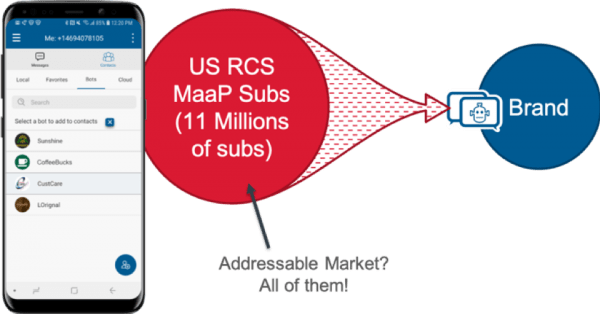RCS MESSAGING AND THE A2P/P2A CONUNDRUM

A joint effort by the GSMA, leading MNOs, suppliers of telecommunications equipment, and application developers led to the creation of the RCS standard, bringing forward a successor to SMS which enhanced the user experience with multimedia capabilities including:
- Audio, images, and video
- Messaging conversations
- Group chat
- Sent, delivered, and read notifications
- Rich cards and rich card carousels
- Buttons for predefined responses or to invoke specific services
- Capability discovery to let brands adapt the experience to the limitations of the consumer device
- Chatbots
With the standardization of the Universal Profile, RCS guarantees a uniform experience across devices and networks. It also includes fallback to SMS and MMS, providing a universal messaging ecosystem in which it is possible to send a message to any user as long as they have a mobile phone number. All these factors will help RCS attain the critical mass of users, millions of eyeballs all focused on a screen that can now become a digital billboard that brands will want to target and mobile network operators (MNO) can monetize.
RCS is no longer a look into the future; it is already here. According to the GSMA, by the end of 2018, 74 operators globally had deployed RCS services to 237 million subscribers, and the expectation is that the number of subscribers will surpass 1.2 billion by 2020.[i] RCS has the support of the leading mobile OS provider (Android) and the leading mobile phone manufacturers (e.g., Samsung), who are including RCS compatible messaging clients (e.g., Android Messages, Samsung Messages) in their devices. Apple is still not providing native RCS support on iOS for the iPhone, but it is expected that RCS will be implemented as a fallback mechanism in iMessage (similar to SMS and MMS) as soon as RCS is available in the major MNOs. In the meantime, vendors such as Mavenir provide downloadable clients for iOS and client SDKs to add RCS capabilities to existing iOS applications.
In the markets where RCS has already been deployed commercially or in commercial trials, RCS is already providing results. For example, in a recent RCS Business Messaging Lab hosted by GSMA during the Mobile World Congress Americas in 2018, several brands presented their early results comparing RCS campaigns to SMS:
- Subway has already seen a 146% lift in usage and a 50-60% increase in conversion rate on their RCS A2P campaigns
- Express confirmed high engagement and loyalty engagements on their RCS A2P campaign with 60% of consumers preferring it over the SMS experience, and their lowest ever opt-out rate in a campaign.
- Vodafone showed uplifts in click-through rate of 700% for external campaigns and 1300% for internal campaigns and an 800% uplift in activation rates
These promising results are driving brands to demand that MNOs launch RCS Business Messaging in their markets. However, because of the focus in converting A2P campaigns from SMS to RCS, until RCS is fully deployed in the mobile installed base, brands will find reach to be a challenge.
THE CHALLENGES OF FOCUSING ON A2P RCS
SMS is a regulated telecommunications service and Application-to-Person (A2P) messaging is brand initiated. For this reason, A2P requires an opt-in model in which consumers accept by entering their mobile number into a registry to receive communications from the brand. The fact that SMS is ubiquitous ensures brands are able to reach any subscriber in their registry since every mobile number supports SMS messaging.
However, when brands convert their A2P campaigns from SMS to RCS, they find that the number of RCS-enabled users in their subscription list represents a very small fraction (sometimes 1%) of their SMS addressable market. And to further complicate matters, they have to deal with subscribers connected to different mobile network operators, which requires them to launch their RCS A2P campaigns in different RCS Messaging-as-a-Platform (MaaP) implementations. From the practical point of view, instead of adding one RCS channel, they potentially need to add an RCS channel for each MNO operating in the territory they want to target. This increases their costs and limits their return on investment.
This problem will eventually disappear once RCS is globally deployed, however, that will still take a number of years to achieve. There is a workaround, though; instead of having the brand reach the consumer, we can change the model to let the consumer reach the brand. Enter Person-to-Application messaging.

Figure 3 – Limitations on RCS reach during the transitional period (US 3Q18 example)
TURNING THE TIDE FROM A2P TO P2A
Person-to-Application (P2A) messaging is a conversational business messaging engagement that is initiated by the consumer (thus, opt-in is implicit). Typical P2A engagements are chatbots or live chats and cover multiple use cases (reservations, appointments handling, information requests, etc.).
P2A is not an RCS innovation but represents a significant improvement over the SMS experience not only with regards to the global user experience but also the brand discovery mechanism.
RCS clients include a dedicated interface (usually a tab) to search for chatbots or brands using brand names or categories (e.g. food, dance lessons, etc.). This makes brands available to the entire RCS installed base, positioning them just one click away from a business interaction that could lead to a potential sale. Brands can also leverage the RCS search capabilities (just like they leverage web browsers to drive users to their websites) or other existing marketing channels to drive customer awareness to their brand (press, radio or TV ads, web banners, etc.).
RCS P2A is superior to the SMS P2A experience. With SMS based P2A messaging, it is not possible to find a brand. Consumers need to know the shortcode (or the long code) of the brand to be able to initiate a conversation. With RCS, the users just need to start a search from the messaging application tab to find relevant brands in their location that can match their needs.
Finally, considering the top 3 A2P monetization issues are all fraud-related (SIM farms, grey routes and spam) and cost an estimated $1.5 billion per annum globally,[ii] investing on developing a P2A messaging strategy that relies on brand and bot vetting to guarantee a secure and clean communication between the consumer and the brand makes a lot of sense.

Figure 4 – Total reach with RCS P2A (US 3Q18 example)
Download the Connecting the Bots white paper for more information on RCS Business Messaging and how RCS can become another standard messaging channel available in the leading chatbot platforms to facilitate the relationship between brands and consumers.
[i] Mobilesquared: Global RCS Business Messaging Forecasts (2018-2023)
[ii] Mobile Ecosystem Forum: What MNOs think about A2P messaging: Growth, Fraud and RCS, 4Q 2018


